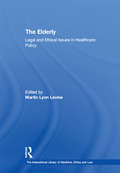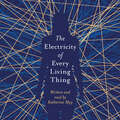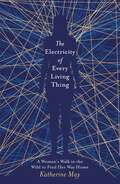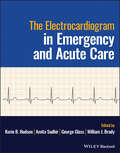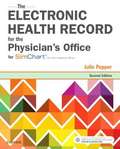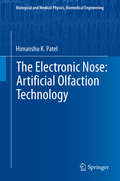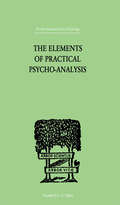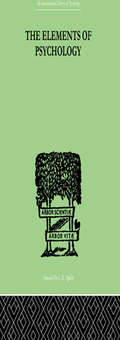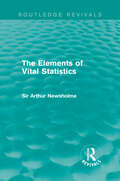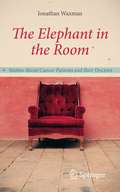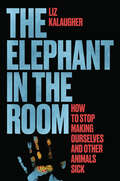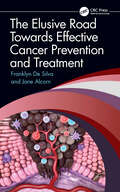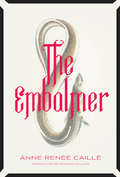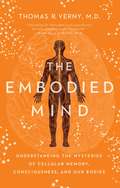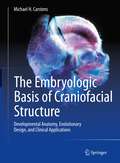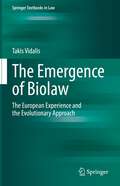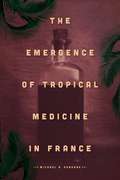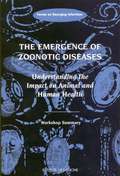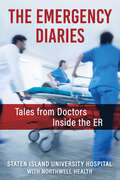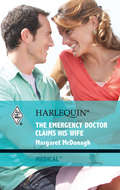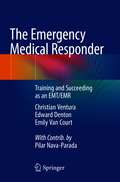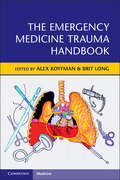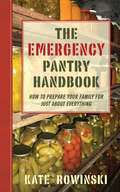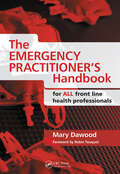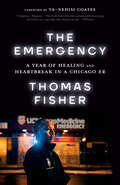- Table View
- List View
The Elderly: Legal and Ethical Issues in Healthcare Policy (The International Library of Medicine, Ethics and Law)
by Martin Lyon LevineAging is a public health priority that is becoming increasingly important in both developed and less developed nations, with individual health care providers and law-makers each facing difficult ethical and policy dilemmas. The complex issues physicians deal with include informed consent and patient decision-making capacity, use of advance care planning and decision-making by family and medical staff, and withdrawing and withholding life-sustaining interventions. Broader questions include: has aging been over medicalized? Is it ethical for older patients to receive less medical care than younger ones, through unspoken practice or formal rationing? Is there inevitable conflict between the generations over scarce medical resources? How should physician, patient and family confront end-of-life decisions? How have different nations responded to increasing numbers of the elderly? Have social values changed as to family responsibility and individual autonomy? This volume brings together the most significant published essays in the field.
The Electricity of Every Living Thing: A Woman's Walk in the Wild to Find Her Way Home
by Katherine MayLast summer, Katherine May was approaching 40, feeling overwhelmed by motherhood and lacking connection with others, lost in a world of inundation and expectation. She had always felt different but this feeling was new. She wanted to get out, get free and find herself again - and so set about walking the rugged 450 mile South West Coast Path. However, this journey uncovers more than she ever imagined. By chance, en route to the walk, Katherine hears a radio show and the guests are speaking about Asperger's Syndrome. Things begin to fall into place - could this explain the white-outs, the excruciating confusion around social contact, the electric feeling of every living thing?After a formal diagnosis, Katherine begins to unravel this new perspective of her life. Through her physical journey comes an emotional one - of accepting who she is and moving forward. It's not just about walking or Asperger's; this is one woman's journey to feel free within herself, something that everyone can relate to.Read by Nathalie Buscombe(p) Orion Publishing Group 2018
The Electricity of Every Living Thing: From the bestselling author of Wintering
by Katherine MayFrom the bestselling author of Wintering, Katherine May, The Electricity of Every Living Thing is a life-affirming and poignant exploration of nature, and how reconnecting to wild landscapes can create peace in our unquiet minds.'A windswept tale, beautifully told' Raynor Winn, author of The Salt Path 'A manifesto for the value of difficult people. I loved it' Amy Liptrot, author of The OutrunIn August 2015, Katherine May set out to walk the 630-mile South West Coast Path. She wanted to understand why she had stopped coping with everyday life; why motherhood had been so overwhelming and isolating, and why the world felt full of inundation and expectations she can't meet. Setting her feet down on the rugged and difficult path by the sea, the answer begins to unfold.The Electricity of Every Living Thing tells the story of the year in which Katherine comes to terms with a diagnosis which shakes her to her core. It leads to a re-evaluation of her life so far - a kinder one, which finally allows her to be different rather than simply awkward, arrogant or unfeeling. The physical and psychological journeys become inextricably entwined, and as Katherine finds her way across the untameable coast, she also finds the way to herself.What readers are saying about The Electricity of Every Living Thing:'Honest and sensitive' 'The astonishing sensitivity and awareness in her writing, both about the beautiful landscapes and nature around on her walks, and in relation to her family, friends and self put paid to many outdated myths about what it is like to be autistic''Compelling and transformative. I could not put this book down so I stayed in bed and read it in one go.''Katherine has a fantastic way with words, I could read her books for hours on end, they are calming and relatable.''Read it - you won't regret it.'
The Electrocardiogram in Emergency and Acute Care
by Amita Sudhir William J. Brady Korin B. Hudson George GlassThe Electrocardiogram in Emergency and Acute Care Clear, practical guidance in mastering ECG interpretation in the critically ill patient The Electrocardiogram in Emergency and Acute Care contains clear, practical guidance on mastering both single-lead and 12 lead ECGs, covering the full range of complexities and including a section on differential diagnosis of more common ECGs, with over 200 tracings from which to learn and self-test. The editors place an emphasis on readability and accessibility, with clearly written chapters and excellent illustrations that serve as a primary source of information for students, trainees, and practicing emergency physicians in all areas. In The Electrocardiogram in Emergency and Acute Care, readers can expect to find detailed information on topics such as: Clinical applications, impact, and interpretation of the electrocardiogram, plus variants of the normal, lead misplacement, and electrocardiographic artifact encountered in clinical practice Cardiac rhythms and cardiac dysrhythmias, covering cardiac rhythms with normal rates, narrow QRS complex tachycardia, wide QRS complex tachycardia, and bradycardia Anatomic and physiologic considerations of ischemic heart disease, historical development of the prehospital electrocardiogram, and electrocardiographic findings in acute coronary syndrome Special populations, high-risk presentation scenarios, and advanced electrocardiographic techniques, covering electrocardiograms in pediatric and poisoned patients The Electrocardiogram in Emergency and Acute Care is ideally suited to medical students, residents, and physicians in training, but is also a useful reference for established physicians as a review and reference text, along with all other health professionals working in this field.
The Electronic Health Record For The Physician's Office: For Simchart For The Medical Office
by Julie PepperThe Electronic Health Record for the Physician's Office, 2nd Edition uses online simulations to walk you through each EHR task. Clear, step-by-step guidelines simplify the exercises in each simulation, so you learn all the EHR skills required of a medical office professional. This edition adds in-depth review and preparation for the Certified Electronic Health Records Specialist (CEHRS) examination. Written by Medical Assisting educator Julie Pepper, this how-to manual helps you master the administrative, clinical, and billing/coding skills you need to gain certification and succeed on the job. Access to SimChart for the Medical Office sold separately.
The Electronic Nose: Artificial Olfaction Technology
by Himanshu K. PatelThis book provides the basics of odor, odor analysis techniques, sensors used in odor analysis and overview of odor measurement techniques. For beginners as well researchers this book is a brief guide for odor measurement and analysis. The book includes a special chapter dedicated to practical implementation of e-nose sensor devices with software utility, which guides students to prepare projects and work in practical analysis. It also includes material from early to latest technology research available in the market of e-nose era. Students and researchers who want to learn the basics of biomedical engineering and sensor measurement technology will find this book useful.
The Elements Of Practical Psycho-Analysis
by Bousfield, PaulFirst Published in 1999. Routledge is an imprint of Taylor & Francis, an informa company.
The Elements Of Psychology
by Thorndike, Edward LFirst Published in 1999. Routledge is an imprint of Taylor & Francis, an informa company.
The Elements of Vital Statistics (Routledge Revivals)
by Sir Arthur NewsholmeFirst published in 1889, this book provides a guide to vital statistics- the science of numbers applied to the life-history of communities and nations- in relation to medical problems. Chapters cover a wide variety of categories including population, births and deaths, sickness, occupation and mortality, and mortality from special diseases.
The Elephant in the Room
by Jonathan WaxmanThe Elephant in the Room is a collection of short stories that creatively communicate the cancer patient's journey. The stories, based on real-life accounts, are built around the idiosyncratic relationships between patients and their doctors. Using humor, empathy and wisdom, Jonathan Waxman explores the very human side of cancer as well as providing expert commentary on the clinical aspects of diagnosis and therapy of this disease. These stories comfort and entertain, inform and engage, and are a treat to read for anyone whose life has been affected by cancer.
The Elephant in the Room: How to Stop Making Ourselves and Other Animals Sick
by Liz KalaugherA healthier future starts with seeing the human causes of wildlife diseases. When new diseases spread, news reports often focus on wildlife culprits—rodents, monkeys and mpox; bats and COVID-19; waterfowl and avian flu; or mosquitoes and Zika. But, in this urgent and engaging book, we see it often works the other way around—humans have caused diseases in other animals countless times, through travel and transport, the changes we impose on our environment, and global warming. With science journalist Liz Kalaugher as our guide, we meet the wildlife we have harmed and the experts now studying the crosscurrents between humans, other animals, and health. Herds of buffalo in Kenya, cloned ferrets in Colorado, and frogs shipped worldwide as living pregnancy tests for humans, all help Kalaugher dive into the murky backstories behind wildlife epidemics past and present. We learn that military conflict likely contributed to the spread of rinderpest, or cattle plague, throughout Africa, devastating pastoral communities. That crowded poultry farms may create virulent new forms of bird flu that spill back into the wild. And that West Nile virus—which affects not only birds and humans, but other animals, including horses, skunks, and squirrels—is spreading as global temperatures rise. Expanding today’s discussions of environmental protection to include illness and its impact, Kalaugher both sounds the alarm and explores ways to stop the emergence and spread of wildlife diseases. These solutions start with a simple lesson: when we protect other animals, we protect ourselves.
The Elusive Road Towards Effective Cancer Prevention and Treatment
by Franklyn De Silva Jane AlcornCancer will remain a global major health problem unless new diagnostic, prognostic, and management approaches are discovered to address both loss of life and quality of life. Here we summarize the general physiology, pathology, heterogeneity, and evolution of cancer, current status, limitations and challenges associated with prevention, incidence, treatment, survival, and mortality, as well as future directions with regards to solid tumors. Perspectives are provided on how to improve pre-clinical understandings, outcomes, and patient care. Further, this comprehensive, timely overview of the literature has educational value as part of an academic course, seminar, or as a supplementary text.
The Embalmer
by Anne-Renée CailléHe tells her about cases he remembers. THe two young women found in the forest, the drowned boy whose organs were eaten by eels, the casket that caught on fire at the funeral. He reveals the secrets of his profession. The powder that comes in a ketchup-sized packet and is injected into the cheeks for that blushing look, the candle wax used to reconstruct parts of a skull, the perfectly weighted stones in a repatriated soldier's casket. These are the notes of a life spent facing death, of a daughter trying to make sense of her father. Quietly poetic, The Embalmer glimpses at something most would rather look away from.
The Embodied Mind: Understanding the Mysteries of Cellular Memory, Consciousness, and Our Bodies
by Thomas R. VernyAs groundbreaking synthesis that promises to shift our understanding of the mind-brain connection and its relationship with our bodies.We understand the workings of the human body as a series of interdependent physiological relationships: muscle interacts with bone as the heart responds to hormones secreted by the brain, all the way down to the inner workings of every cell. To make an organism function, no one component can work alone. In light of this, why is it that the accepted understanding that the physical phenomenon of the mind is attributed only to the brain? In The Embodied Mind, internationally renowned psychiatrist Dr. Thomas R. Verny sets out to redefine our concept of the mind and consciousness. He brilliantly compiles new research that points to the mind&’s ties to every part of the body. The Embodied Mind collects disparate findings in physiology, genetics, and quantum physics in order to illustrate the mounting evidence that somatic cells, not just neural cells, store memory, inform genetic coding, and adapt to environmental changes—all behaviors that contribute to the mind and consciousness. Cellular memory, Verny shows, is not just an abstraction, but a well-documented scientific fact that will shift our understanding of memory. Verny describes single-celled organisms with no brains demonstrating memory, and points to the remarkable case of a French man who, despite having a brain just a fraction of the typical size, leads a normal life with a family and a job. The Embodied Mind shows how intelligence and consciousness—traits traditionally attributed to the brain alone—also permate our entire being. Bodily cells and tissues use the same molecular mechanisms for memory as our brain, making our mind more fluid and adaptable than we could have ever imaged.
The Embryologic Basis of Craniofacial Structure: Developmental Anatomy, Evolutionary Design, and Clinical Applications
by Michael H. CarstensFocusing on the anatomy of the head and neck, this book begins at the cellular level of development, detailing bone, muscle, blood supply, and innervation along the way. It illustrates the origin of each tissue structure to aid in making prognoses beyond the surface deformation, offering typical issues seen in the craniofacial region, for example. Written by a pediatric Craniofacial plastic surgeon and intended for clinicians and residents in the areas of plastic surgery, ENT, maxillofacial surgery, and orthodontistry, this book is the first of its kind to focus so intently on evolution of the craniofacial structure. It is neatly broken up into two distinct sections.The first section is meant for readers to gain a fundamental understanding of the development of craniofacial structures, from embryo onward, relying on the concepts of the Neuromeric Theory. The chapters in the first section of the book trace the development of the typical patient. The second section offers clinical examples of how the Neuromeric Theory can be used to repair or reconstruct various regions of the head and neck. Craniofacial clefts, including cleft lip and palate, ocular hypotelorism, anencephaly, craniosynostosis and more are detailed. Understanding the formation of the tissue structures involved in any given genetic deformation or anomaly enables the clinician to provide a more satisfying outcome for the patient, both structurally and aesthetically. New and current therapeutic options are explored and supported through original illustrations and photographs to aid in determining the best treatment for each individual patient.Embryological Principles of Craniofacial Structure bridges the gap between introductory books on the basic anatomy of the head and neck and the detailed understanding required for corrective surgery of craniofacial defects.
The Emergence of Biolaw: The European Experience and the Evolutionary Approach (Springer Textbooks in Law)
by Takis VidalisThis book introduces “biolaw” as an integrated and distinct field in contemporary legal studies. Corresponding to the legal dimension of bioethics, the term “biolaw” is already in use in academic and research activities to denote legal issues emerging mostly from advanced technological applications. This book is a genuine attempt to rationalize the field of biolaw after almost four decades of continuous production of relevant legislation and judgments worldwide. This experience is a robust basis for defending a) a separate legal object, covering the total of legal norms that govern the management of life as a natural phenomenon in all its possible forms, and b) an “evolutionary” approach that opens the discussion on a future conciliation of legal regulation with the Theory of Evolution on the ground of biolaw.
The Emergence of Tropical Medicine in France
by Michael A. Osborne"The Emergence of Tropical Medicine in France" examines the turbulent history of the ideas, people, and institutions of French colonial and tropical medicine from their early modern origins through World War I. Until the 1890s colonial medicine was in essence naval medicine, taught almost exclusively in a system of provincial medical schools built by the navy in the port cities of Brest, Rochefort-sur-Mer, Toulon, and Bordeaux. Michael A. Osborne draws out this separate species of French medicine by examining the histories of these schools and other institutions in the regional and municipal contexts of port life. Each site was imbued with its own distinct sensibilities regarding diet, hygiene, ethnicity, and race, all of which shaped medical knowledge and practice in complex and heretofore unrecognized ways. aaaaaaaaaaaOsborne argues that physicians formulated localized concepts of diseases according to specific climatic and meteorological conditions, and assessed, diagnosed, and treated patients according to their ethnic and cultural origins. He also demonstrates that regions, more so than a coherent nation, built the empire and specific medical concepts and practices. Thus, by considering tropical medicineOCOs distinctive history, Osborne brings to light a more comprehensive and nuanced view of French medicine, medical geography, and race theory, all the while acknowledging the navyOCOs crucial role in combating illness and investigating the racial dimensions of health. "
The Emergence of Zoonotic Diseases: Understanding the Impact on Animal and Human Health
by Forum on Emerging InfectionsZoonotic diseases represent one of the leading causes of illness and death from infectious disease. Defined by the World Health Organization, zoonoses are those diseases and infections that are naturally transmitted between vertebrate animals and man with or without an arthropod intermediate. Worldwide, zoonotic diseases have a negative impact on commerce, travel, and economies. In most developing countries, zoonotic diseases are among those diseases that contribute significantly to an already overly burdened public health system. In industrialized nations, zoonotic diseases are of particular concern for at-risk groups such as the elderly, children, childbearing women, and immunocompromised individuals. The Emergence of Zoonotic Diseases: Understanding the Impact on Animal and Human Health, covers a range of topics, which include: an evaluation of the relative importance of zoonotic diseases against the overall backdrop of emerging infections; research findings related to the current state of our understanding of zoonotic diseases; surveillance and response strategies to detect, prevent, and mitigate the impact of zoonotic diseases on human health; and information about ongoing programs and actions being taken to identify the most important needs in this vital area.
The Emergency Diaries: Stories from Doctors Inside the ER
by Northwell's Staten Island University HospitalHarrowing and hopeful tales from doctors inside the emergency room at Staten Island University Hospital—one of the flagship hospitals of Northwell Health, New York&’s largest health care provider Open 24 hours a day, 365 days a year—through winter storms, hurricanes, and global pandemics—emergency rooms are vital to the safety of any community. Day in and day out, thousands of patients pass through their doors to address their immediate medical needs. From life-threatening illnesses to minor ailments, ER doctors and nurses are the first line of defense when something goes wrong with our bodies. Written as a series of essays and stories by real ER doctors, The Emergency Diaries gives readers a glimpse into the hearts and minds of medicine&’s finest, and the seemingly insurmountable challenges these everyday heroes face. Doctors recount firsthand the challenging nature of their profession and share pivotal moments in their medical careers that have stuck with them to this day. Whether it&’s delivering the bad news or making split-second decisions to save lives, the extremes of this profession can be overwhelming. ER doctors and nurses are under incredible pressure to act with grace, precision, and mental fortitude when caring for their patients. Larger national events—like the opioid epidemic, natural disasters, and the coronavirus pandemic—have only exacerbated this stress in recent years. This poignant-yet-hopeful book tells their stories and serves as a testament to their incredible resilience and sacrifice for the greater good.
The Emergency Doctor Claims His Wife
by Margaret McdonaghWhen a tall, dark-haired drop-dead-gorgeous new doctor strides through the doors of Strathlochan Hospital, pulses start racing--especially Dr. Anne Webster's! Five years ago she and Nathan Shepherd broke up, and she's never gotten over it. Though they have very different recollections of their breakup, whatever the tensions between them, neither can deny the smoldering passion they still share. It's clear to Nathan they have unfinished business, and this time he's not leaving without answers...or his woman
The Emergency Medical Responder: Training and Succeeding as an EMT/EMR
by Christian Ventura Edward Denton Emily Van CourtEmergency medical service providers serve as the primary immediate response to emergencies of all kinds, including natural disasters and acts of terrorism in the United States, with states serving as the regulatory agencies responsible for training, scope of practice, and continuing education for potential and working EMS providers. This text serves as a comprehensive guide to individuals in training to become emergency medical service providers and complements Emergency Medical Technician (EMT) and Emergency Medical Responder (EMR) courses as the primary classroom text consistent with National EMS Curriculum Standards and other industry guidelines. Each chapter addresses a relevant organ system and its physiology, methods of assessment, treatment recommendations, along with a case study to illustrate the topics at hand. So much of what is involved in emergency medical services is based on practical and applicable knowledge of situations, and these case studies will provide students with exposure to the field work they will be responding to. Written with the context of COVID-19 implications in mind, this is first EMT text of its kind produced after the onset of the pandemic, with considerations and citations from national and international emergency medicine journals to incorporate guidelines and best-practices in light of shifting conditions and expectations.
The Emergency Medicine Trauma Handbook
by Brit Long Alex KoyfmanTrauma is a leading cause of death and disability around the world, and the leading cause of death in those aged under forty-five years. Conditions such as airway obstruction, hemorrhage, pneumothorax, tamponade, bowel rupture, vascular injury, and pelvic fracture can cause death if not appropriately diagnosed and managed. This essential book provides emergency physicians with an easy-to-use reference and source for traumatic injury evaluation and management in the Emergency Department. It covers approaches to common, life-threatening, and traumatic diseases in the Emergency Department, for use on shift and as a reference for further learning. Each chapter includes a succinct overview of common traumatic injuries, with evaluation and management pearls and pitfalls. Highly illustrated with images from one of the busiest trauma centers in the US, and featuring expert contributions from a diverse set of attending physicians, this is an essential text for all emergency medicine practitioners.
The Emergency Pantry Handbook: How to Prepare Your Family for Just about Everything
by Kate Rowinski Jim RowinskiIn today’s world, anything can happen—medical emergencies, power outages, natural disasters. In less time than it takes to sign off on an insurance form, the world as we know it can be brought to a standstill. There can be no question: It’s best to be prepared. The Emergency Pantry Handbook by cooking expert and readiness enthusiast Kate Rowinski offers tips, techniques, and advice on how to keep your family safe, well-fed, and fully supplied in the event of any crisis. With simple instructions, Rowinski demonstrates how to create an emergency strategy; how to protect your house, documents, and keepsakes; and how to prepare for specific disasters. Offering a unique twist on preparation handbooks, Rowinski focuses on food storage and cooking—put simply, how to plan nutritional emergency meals and avoid “making due” on canned meats and chocolate bars. The Emergency Pantry Handbook details:· Storage techniques · Personalizing your food plan · Stockpiling, shelf life, and rotation · Pickling, canning, sprouting, and drying · Making delicious dinners out of your storage pantry Whether a disaster lasts for twenty-four hours or twenty-four weeks, The Emergency Pantry Handbook is the ultimate guide to keeping your family eating healthily and maintaining proper nutrition, even in the worst of circumstances.
The Emergency Practitioner's Handbook: For All Front Line Health Professionals
by Mary DawoodThe development of urgent care centres within emergency departments and the proliferation of minor injury units and walk in centres in recent years has led to a parallel rise in Emergency Practitioners (EPs) whose professional backgrounds range between nursing, physiotherapy and paramedical sciences with nurses being the predominant group. These hybrid groups of clinicians combine nursing and medical knowledge to deliver timely effective care to patients presenting with a wide range of injuries and illness. This handbook is an ideal companion and aide memoire for daily practice, and an essential tool for EPs - enabling them to assess, diagnose, treat and discharge or refer the patient effectively. Written by emergency nurse practitioners who understand the thought processes and complexities of clinical decision making, this guide offers straightforward practical advice, particularly for those in isolated nurse led units or those working in a pressurised environment of the emergency department. General Practitioners and foundation year 2 doctors also increasingly work in emergency/urgent care settings and will find this guide invaluable for current, easy to access information.
The Emergency: A Year of Healing and Heartbreak in a Chicago ER
by Thomas FisherThe riveting, pulse-pounding story of a year in the life of an emergency room doctor trying to steer his patients and colleagues through a crushing pandemic and a violent summer, amidst a healthcare system that seems determined to leave them behind ONE OF NEWSWEEK&’S MOST ANTICIPATED BOOKS OF 2022As an emergency room doctor working on the rapid evaluation unit, Dr. Thomas Fisher has about three minutes to spend with the patients who come into the South Side of Chicago ward where he works before directing them to the next stage of their care. Bleeding: three minutes. Untreated wound that becomes life-threatening: three minutes. Kidney failure: three minutes. He examines his patients inside and out, touches their bodies, comforts and consoles them, and holds their hands on what is often the worst day of their lives. Like them, he grew up on the South Side; this is his community and he grinds day in and day out to heal them. Through twenty years of clinical practice, time as a White House fellow, and work as a healthcare entrepreneur, Dr. Fisher has seen firsthand how our country&’s healthcare system can reflect the worst of society: treating the poor as expendable in order to provide top-notch care to a few. In The Emergency, Fisher brings us through his shift, as he works with limited time and resources to treat incoming patients. And when he goes home, he remains haunted by what he sees throughout his day. The brutal wait times, the disconnect between hospital executives and policymakers and the people they're supposed to serve, and the inaccessible solutions that could help his patients. To cope with the relentless onslaught exacerbated by the pandemic, Fisher begins writing letters to patients and colleagues—letters he will never send—explaining it all to them as best he can. As fast-paced as an ER shift, The Emergency has all the elements that make doctors&’ stories so compelling—the high stakes, the fascinating science and practice of medicine, the deep and fraught interactions between patients and doctors, the persistent contemplation of mortality. And, with the rare dual perspective of somebody who also has his hands deep in policy work, Fisher connects these human stories to the sometimes-cruel machinery of care. Beautifully written, vulnerable and deeply empathetic, The Emergency is a call for reform that offers a fresh vision of health care as a foundation of social justice.
